
Text style guide
FOR GALLERY WRITERS (PUBLICATIONS)
01 INTRODUCTION
This style text guide focuses on those aspects of language and style that have specific relevance
to National Gallery of Australia (NGA) publications. It has been prepared to guide internal and
external authors and editors and enable consistency.
More specific and detailed style sheets are prepared for individual exhibitions or books if required.
APPROACH
The Gallery’s mission is to make the national art collection accessible and to engage with a broad
audience. Gallery publications should be scholarly in their research, as well as accessible and
engaging.
Text should appeal to interested general reader as well as specialists in Australia and
internationally. The Gallery’s aim is to minimise reading interruptions by applying a minimal (or
open) style to punctuation and capital letters. Punctuation that does not carry meaning or add
clarity to a text is omitted.
The style guide assists the Gallery to project an image of an inclusive, forward-looking, relevant
and scholarly institution for all Australians.
1
02 ABBREVIATIONS
Abbreviations are used only when there are space constraints such as in captions, notes and
bibliographies.
Follow minimal or open punctuation style: no full stops. Common usage abbreviations include:
eg
for example (
exempli gratia)
etc
and other things (
et cetera)
ie
that is (
id est)
fax
facsimile
St
street
tel
telephone
Common scholarly abbreviations
app
appendix
b
born
c
circa (with thin space before date: c 1920)
comp
compiled by
ed/eds
editor/s
edn
edition
est
established
et al
and others (
et alii)
fig/figs
figure/s
ill/ills
illustration/s
n/nn
note/s
nd
no date
no/nos
number/s
np
no place (or no publisher details) par/pars
paragraph/s
pl
plate
rev edn
revised edition
ser
series
suppl
supplement
trans
translated by
vol/vols
volume/s
Initials and acronyms
Initials are contracted with no spaces or full stops:
JMW Turner HO Havemeyer
Acronyms are contracted with no spaces or full stops
NGA
AGNSW
DEWHA
Titles
Titles are contracted with no full stops:
Mr
Mrs
Ms
Dr
Prof (but spel out in full ‘Professor Emeritus’)
2
Spel out in full ‘Saint’ for a person (eg Saint Peter) but contract for a building (eg St Peter’s
Basilica).
Honours, awards and academic qualifications
See ‘Postnominals: honours, awards and academic qualifications’.
03 AMPERSANDS (&)
In company and institution names and newspaper titles, an ampersand is used where it is part of
the official proprietary, firm or institutional name (eg V&A Museums, Fortnum & Mason, Knock &
Kirby). The same applies for publishers and for titles of newspapers: Thames & Hudson, Brandl &
Schlesinger,
Perth Gazette & WA Times (see
SM p 158, an organisation’s title should be used in
the form shown on its letterhead).
In citations/references (see
SM p 193) an ampersand is used for an in-text citation for joint authors
when it is enclosed in parentheses; the spel ed out word ‘and’ is used when the names are
incorporated into the text: This was argued as untrue (Miller & Gupta 1995)
but Miller and Gupta
(1995) disagreed with the study.
Similarly, ampersands are specified for reference lists:
Australian Bureau of Statistics & Australian Institute of Health and Welfare 1997
Miller, TB & Gupta, K 1995
04 APOSTROPHES
Follow minimal use of apostrophes, ie not necessary when the associated word is used
adjectivally:
drivers licence
teachers notes
Members Lounge
Sponsors Circle
childrens trail
See also ‘Possessives’.
05 ARTISTIC SCHOOLS, MOVEMENTS, PERIODS AND ERAS
Maximum capitals, not italicised.
Cubism (noun)
but cubist (adjective)
Surrealism
but surrealist
Formalism
but formalist
Impressionism
but impressionist
The Futurists
the Great Depression
3
06 ARTISTS’ NAMES AND DATES
See
Grove art online for international artists.
07 BRACKETS
As per standard English usage (see
SM, pp 110–12).
Parentheses
Parentheses are used to enclose definitions, comments, additional information, asides and
translations. For example:
He is one of few people who can still play the bandore (an ancient guitar).
Edgar Degas and a group of his friends decided they would no longer show with the Salon
(although, a number of them still did).
This exhibition of
pichhavai (shrine hangings) draws from the TAPI collection in India.
The phrase
l’art pour l’art (‘art for art’s sake’) is believed to have been coined by Théophile
Gautier.
See also ‘Languages other than English’ and ‘Titles’.
Square brackets
Square brackets are used mainly in quoted matter to signify editorial interpolation, or an insertion
made by someone other than the author (see
SM pp 99, 111–12, 154). They are used to clarify,
add further information, or to indicate errors in the original text. For example:
He writes in his biography, ‘I grew up in Sydney but was born in Gunning [New South Wales],
where my father ran a newspaper’.
‘The High Court [located in Canberra] is the highest court in the land.’
‘The BJP [Bharatiya Janata Party] and the Congress have both acknowledged this.’
‘Jason Smith and Dick Roberts worked on the project for three years. Roberts worked in the
laboratory, although Smith claimed that he [Smith] was responsible for the main work.’
Note: when ‘[
sic]’ (= thus) is used, it should be kept to a minimum, as it is intrusive and blocks the
flow of the text. The preferable style is to use the correct spelling eg: ‘We live in Canberra but used
to live in Melberne [Melbourne]’ or ‘… in Melb[ou]rne’. Alternatively, a general note at the front of
the book could indicate that spellings have been corrected or amended to modern usage etc.
Square brackets are not required in text when giving an alternative title for a work, unless
specifically used to indicate that the work’s title was/is not known, and that the enclosed title is an
unofficial one created by the curator. Except for an unofficial title of a work, round brackets
4
(parentheses) should be used in all running text, eg
Luncheon on the grass (
Déjeneuner sur
l’herbe) …
08 BULLETED LISTS
Use minimal punctuation: no commas or semicolons at the end of each bulleted item.
Bulleted lists that are not complete sentences, or that run on from a sentence before the list, begin
with a lowercase letter and only the last item in the list should have a full stop (if it is the end of the
sentence):
The National Gallery of Australia’s functions as provided in the Act are to:
▪ develop and maintain a national art collection of works of art
▪ exhibit, or make available for exhibition by others, works of art from the national collection, or
works of art that are otherwise in the possession of the Gallery
▪ use every endeavour to make the most advantageous use of the national collection in the
national interest.
Bullets that are a complete sentence start with an initial capital letter and end with a full stop:
The Gallery has three important functions outlined in the Act:
▪ A national collection of works of art must be developed and maintained.
▪ Works of art from the national art collection, or works of art that are otherwise in the
possession of the Gallery, are to be exhibited or made available for exhibition by others.
▪ Every endeavour should be made to ensure the most advantageous use of the national
collection in the national interest.
09 CAPTIONS
Types of captions may vary depending on the images and how they are published.
Full caption
Used in lists of works and for all exhibition book entries, even when it is a detail or a full work that
is also in the catalogue of works (note: the acquisition number is only included in lists of works, not
in entry captions). It includes all relevant information about the artist and work of art:
Eugène Grasset
gift of Orde Poynton Esq, AO, CMG, 1993
Switzerland 1845 – France 1917
93.2045
The acid thrower (
La vitrioleuse) c 1896
IRN 179184 [deleted before printing]
lithograph
Frederick McCubbin
image 40 x 37.7 cm
Australia 1855–1917
sheet 60.6 x 44 cm
The coming of spring 1912
National Gallery of Australia, Canberra
5
oil on canvas
purchased 1976
68.8 x 102 cm
76.1570
National Gallery of Australia, Canberra
IRN 42250 [deleted before printing]
Half caption
Used in
artonview and other publications. It does not include full details about the artist or the
accession number:
Eugène Grasset
Frederick McCubbin
The acid thrower (
La vitrioleuse) c 1896
The coming of spring 1912
lithograph
oil on canvas
image 40 x 37.7, sheet 60.6 x 44 cm
68.8 x 102 cm
National Gallery of Australia, Canberra
National Gallery of Australia, Canberra
gift of Orde Poynton Esq, AO, CMG, 1993
purchased 1976
IRN 179184 [deleted before printing]
IRN 42250 [deleted before printing]
Merchandise/printed cards caption
Includes artist, title (translation), date, materials, collection/credits:
Eugène Grasset
Frederick McCubbin
The acid thrower (
La vitrioleuse) c 1896
The coming of spring 1912
lithograph
oil on canvas
National Gallery of Australia, Canberra
National Gallery of Australia, Canberra
gift of Orde Poynton Esq, AO, CMG, 1993
purchased 1976
IRN 179184 [deleted before printing]
IRN 42250 [deleted before printing]
Media/short publication caption
Where space is limited. It includes essential information only—artist, title, date, collection/credits—
and can be in two forms, depending on space and style of publication (A. list
or B. run-on):
A. list format
Eugène Grasset
Frederick McCubbin
The acid thrower (
La vitrioleuse) c 1896
The coming of spring 1912
National Gallery of Australia, Canberra
National Gallery of Australia, Canberra
gift of Orde Poynton Esq, AO, CMG, 1993
purchased 1976
IRN 179184 [not visible on printed copy]
IRN 42250 [not visible on printed copy]
B. run-on format
Eugène Grasset The acid thrower (
La vitrioleuse) c 1896, National Gallery of Australia, Canberra, gift of
Orde Poynton Esq, AO, CMG, 1993
IRN 179184 [deleted before printing]
Frederick McCubbin The coming of spring 1912, National Gallery of Australia, Canberra, purchased
1976
IRN 42250 [deleted before printing]
6
Details
A detail of a work of art (or cropping of an image) can be used if copyright permits. Details are
indicated by adding ‘(detail)’ after the year created:
The acid thrower c 1896 (detail)
Descriptive captions
Used for events and other images that are not works of art, and may include a photography credit,
indicated by ‘Photograph:’ followed by the photographer’s name:
Imants Tillers at Blairgowrie, Cooma, 2006. Photograph: Sonia Payes
Caption combinations
Where necessary, a combination of the work of art caption and descriptive caption may be used.
For instance, when it is relevant to indicate where a work is installed:
Lauren Berkowitz
Bags 1994
polyethylene bags
installation
400 x 600 x 100 cm (variable)
collection of the artist
installed at the Ian Potter Museum of Art, The University of Melbourne, 1998
photograph: John Gollings
Collection credit
Lowercase ‘collection’ when referring to collections.
10 COMMAS
Commas are perhaps the most versatile punctuation mark in the English language. They are used
in lists and strings of adjectives, and to set apart coordinate clauses, defining and non-defining
clauses, adjectival and adverbial clauses and introductory, appositional and parenthetical
expressions. They are used to avoid ambiguity; where there is no ambiguity, no comma is
required.
For simple lists do not use the Oxford comma, ie no comma before the word ‘and’, eg exhibitions,
books, radio and television programs, plays, websites and albums.
7
11 DASHES: EM AND EN DASHES
Em rule
Use
unspaced em dashes—like this—to set apart parenthetic elements. In designed text dashes
should appear at the end of a line rather than at the beginning of the next line if it runs over two
lines.
If one parenthetical statement is made within another use a combination of the em rule and
parentheses:
The Industrial Revolution saw the emergence of a new social order with new social
stratifications—it saw, for example, the emergence not only of a new merchant class but also of
a wealthy middleclass (a bourgeoisie) and an urban proletariat.
En rule
Use en dashes to indicate spans of figures, time and distance.
The en dash is
unspaced when it spans only one set of numbers.
1890–1924
pp 29–30, 33–5
10.00–11.00 am
19th–20th century
For more on number spans, see ‘Numbers’.
However, the en dash is
spaced when it spans more than one set of numbers.
12 noon – 8.00 pm
52 BCE – 108 CE
1 January 1890 – 2 January 1924
The en dash is also used to indicate an association between words that retain their separate
identities.
hand–eye coordination
Asia–Pacific region
parent–child relationship
12 DATES
Dates should always be in the following order: day month year.
In body text, the day should always be given as a numeral, the month spelt out in full and the year
as the full four-digit numeral.
4 March 2004
not 4th March 2004 or 4 March 04
Years
Always use the full four digits. Do not use possessive ‘s’ when referring to blocks of time:
1989
not ’89 or 89
1940s
not 1940’s or 1940s’
For early, mid and late (no hyphen), eg ‘… in the mid 1970s’, but use hyphen when adjectival, eg
‘mid-1970s fashion’.
8
Centuries
In publications spell out in full:
nineteenth century
not 19th century
and hyphenate when adjectival:
nineteenth-century painting
not nineteenth century painting
For signage, wall text, marketing materials and advertisements etc, where readers are standing up
or where space is limited, use numerals:
19th century
20th century
Circa
In captions and lists of works use ‘c’ before the date, with no full stop.
13 DIACRITIC MARKS
No accents on foreign names or words when in capitals, only when lower case:
CEZANNE
but Cézanne
Etude de femme not
Étude de femme
Ecole nationale supérieure des beaux-arts
not École nationale supérieure des beaux-arts
14 DIMENSIONS
Use metric not imperial. Dimensions for works of art should be given in centimetres and in order of
height x width x depth (as noted either at front of a publication or at the head of the list of works).
Do not include decimal points if they are zero or abbreviations for height, width and depth. Always
place the abbreviated unit type (eg cm, kg) after the last measurement only and with a single
space before it. (Note: this is a change in keeping with current art museum publishing usage to
make texts as accessible as possible by omitting text/data which does not carry meaning or add
clarity. See Introduction p 3.)
12 cm
not 12.0 cm or 12cm
12 x 50.6 cm
not 12 h x 50.6 w cm or 12 cm x 50.6 cm
To note a specific type of measurement, include abbreviated note in parentheses directly after the
measurement/s to which it refers.
12 x 50.6 (diam) cm
12 x 50.6 cm (irreg)
To identify a particular element that is being measured, indicate it before the measurement.
sheet 12 x 50.6 cm
image 10 x 48.6 cm
9
box 18.5 x 42.2 x 10 cm
board 46 x 42 cm
15 ELLIPSIS
Use a spaced ellipsis (…) to show the omission of a word or words from quoted material:
‘Two early masterpieces by Friedrich …
View of the Elbe Valley c 1807 and
Dolmen in the snow
1807.’
16 HYPHENATION
As per standard English usage. See
SM, pp 88–94.
Prefixes
pre-eminent
semi-official
hyper-real
Compound words
still-life painting
40-year-old man
four-part series
co-dependant
but coordinator, coordinate, cooperate
early nineteenth-century art (first two words not hyphenated)
17 ITALICS
Use italics for foreign words unless they have been absorbed into the English language (see
‘Languages other than English’ for more information).
Published titles, works of art, films, journals etc are also italicised. See ‘Titles’ for more information
and examples.
Italics can also be used to give particular emphasis to a word—although this style should not be
overused.
18 LANGUAGES OTHER THAN ENGLISH
Foreign languages
Use italics for foreign words unless they have been absorbed into the English language (see
SM,
pp 148–9). To distinguish foreign-language words from those that have been absorbed use the
Macquarie dictionary:
10
fin de siecle etude
bourgeoisie
cafe
résumé (note that the accents of the original French word are retained for meaning)
Zeitgeist (note that initial capital of the original German word is retained)
The grammar and style of a foreign language should be followed for the original language only, not
for the English translation, eg all nouns are capitalised in German. Provide translation, not
italicised, in parentheses directly after the original word or phrase:
This exhibition of
pichhavai (shrine hangings) draws from the TAPI collection in India.
Depending on which term you want to continue with in a text, you could present the text above as:
This exhibition of shrine hangings, or
pichhavai, draws from the TAPI collection in India.
Foreign proper names are not italicised but should be translated if not commonly known:
Clementine-Hélène Dufau
Dadang Christanto
Brahma
Allah
Shiva
Mogulapan
Académie des Beaux-Arts
Museum für Angewandte Kunst (Museum of Applied Art)
For titles of works of art, use English title first, followed by foreign-language title in un-italicised
parentheses:
Luncheon on the grass (
Déjeuner sur l’herbe)
Exceptions: a work that has literary intent, eg
Joie de vivre, would not be translated.
Note: for marketing and programs brochures aimed at a general audience and where space is at a
premium, no foreign-language title is used.
Aboriginal and Torres Strait Islander languages
As Indigenous Australian languages are not foreign language they are not italicised; however,
English translation should be give in parentheses after the word or phrase in the same manner as
foreign words or phrases:
Lorrkkon (hollow log coffins) are used to inter the remains of the deceased.
Note: always use capital ‘I’ for indigenous when referring to Indigenous Australians, eg ‘the
Indigenous people of Australia’. Lowercase ‘I’ for generic use, eg ‘the indigenous peoples of the
world’ and ‘this plant is indigenous to Australia’.
Quotes
When quoting from a foreign-language source, use English only, unless the original language
provides something important to the meaning. See Appendix 1 ‘Referencing: notes and
bibliographies’ for notes on referencing translated texts and original language texts.
11
19 NATIONAL GALLERY OF AUSTRALIA
The Director
Nick Mitzevich
Credit line
National Gallery of Australia, Canberra
Street address
Parkes Place, Canberra
not Parkes Place, Parkes
20 NOTES
Use endnotes not footnotes. See Appendix 1 ‘Referencing: notes and bibliographies’.
21 NUMBERS
Spell out numbers up to and including nine; use numerals for 10 and above. No space is used for
numbers up to and including four digits, eg 100, 1000, 9999 (
not 1,000 or 1#000).
For numbers of five digits and above, a space is used eg, 10 000. You can indicate this with a
double hash (##) eg 10##000. This will appear as a fine space in designed text.
Number spans should be limited to those essential for clarity:
9–12
40–1
45–50
402–5
421–39
but
11–12
not 11–2, and 113–15
not 113–5
For dimensions, do not include ‘.0’ eg, 24.5 x 30
not 24.5 x 30.00. See also ‘List of works and
captions’. See also ‘Telephone and fax numbers, web and email addresses’.
22 POSSESSIVES
Singular common nouns
For singular common nouns, insert an apostrophe before the possessive s; even if they end in s:
the Gallery’s policies
lens’s range
government’s budget
Plural common nouns
For plural nouns ending in s, simply insert an apostrophe after the s. For plural nouns not ending in
s use the apostrophe s:
policies’ consequences children’s drawings
state governments’ budgets
Proper nouns
The rule for singular common nouns also applies to proper nouns:
12
Twombly’s
Picasso’s
Roger’s
Roberts’s
Eames’s
Degas’s
The exception to this rule is where the person is the main subject of a manuscript and will appear
often—in this case, follow the style Degas’ not Degas’s.
Years are not possessive and should never carry a possessive s:
1980s
not 1980’s or 1980s’
See also ‘Apostrophes’ for when
not to use an apostrophe.
23 POSTNOMINALS
Use in formal address and list of names, address lines and image credit lines. In body copy, only
use in first instance. See
SM, pp 504–18, for order of placement, forms of address etc.
Do not use postnominals in headings.
To check that you have the correct and most recent postnominal honour for a particular person
and for other information, search the website
It’s an honour at itsanhonour.gov.au.
No commas are used after the name to separate it from the first postnominal but they are used
before any subsequent postnominals:
John Olsen AO, OBE
Orde Poynton Esq, AO, CMG
The Hon Peter Garrett AM, MP
Arthur Biggs CMG, PhD, MP
24 QUOTATIONS
Quotes should be transcribed accurately, retaining the punctuation, capitalisation, original
spellings, emphasis and errors of the original. However, at authorial discretion spellings may be
corrected with a note to that effect at the front of the book.
Use single quotation marks ‘ ’ on either side of a quote and double quotation marks “ ” for a quote
within a quote. For example:
As he had written in his letter to Jones: ‘Then he said to me, “go away!”, but I refused’.
Full stop should go outside quotation marks if any part of the sentence is not quoted matter and
inside if the whole sentence is the quotation:
‘This colour is atrocious! We
must get Georgio to fix it.’ That was what he was like when he was
working.
13
The Director noted, ‘Much needed behind-the-scenes facilities have been added’.
For spelling errors, place the correct spelling in square brackets directly after the mistake made in
the original text:
‘What can we do before the plain [plane] lands?’
‘We live in Canberra but used to live in Melbern [Melbourne].’
Quotes over about 30 words should be indented by one (1) centimetre form the left-hand margin,
without quotation marks.
25 REFERENCING
See Appendix 1 ‘Referencing: notes and bibliographies’.
26 SPECIALIST AND CULTURALLY SPECIFIC TERMS
Use the specialist term followed by the translation or explanation in parenthesis:
cliché-verre (a print made by passing light through an etched glass plate onto photosensitive
paper)
pichhavai (shrine hangings)
scrimshaw (a carved or engraved article made by whalers from the teeth and bones of whales
or walruses)
nef (a ship-shaped ornament)
mana (spiritual power or authority in Polynesian culture)
27 SPELLING
Use standard English spellings unless a specific spelling is required for a specialist audience:
-ise
not -ize (recognise, organise, dramatise, civilised etc)
-our
not -or (colour, flavour, honour, etc)
The author of a manuscript should keep their own alphabetical spelling chart, noting particular
spellings for specialised words and for words in languages other than English. This chart can then
be referred to by other authors, editors and proofreaders to ensure consistency and that any
deviations from common spellings are maintained.
28 TELEPHONE AND FAX NUMBERS, WEB AND EMAIL ADDRESSES
Telephone and fax numbers
(02) 6240 XXXX (for national distribution)
+ 61 2 4260 XXXX (for international distribution)
14
Web and email addresses
Use all lowercase for both web and email addresses. Standard web addresses do not require the
prefix http://www; however, specialised prefixes should be retained, eg https://www. (secure site)
and ftp://www. (file transfer protocol).
xxxx.xxxxxx@xxx.xxx.xx
nga.gov.au
nga.gov.au/degas
https://www.ntbank.com.au
29 TIMES OF DAY
Use a single stop to separate the hour and the minutes, and no space before the am and pm.
Remove the two zeros for whole hours:
9.45am
6.30pm
3.00pm
12pm
not 12 noon
Time spans
Apply the same en rule to spans of time of day as for any other span (see ‘Dashes: em and en
dashes’):
Unspaced if the en dash spans a single element
9–11am
1.15–3pm
9.38–12.58pm
Spaced if the en dash spans more than one element
11am – 6.30pm
10.15am – 12pm
11pm – 1am
30 TITLES
It is essential to differentiate titles from running text and to have standardised styles to aid reader
recognition (in much the same way initial capitals are used to begin a sentence or identify a proper
noun). As with works of art, most other title forms follow the same style ie italics and minimal
capitals.
Works of art and series
Italics and minimal capitals:
Shearing shed, Newstead
Mourners and dead house at Kalo, New Guinea
The first mention of a work of art or series in an essay or chapter must include the year it was
created. The year immediately follows the title with no punctuation and only a single space
between them:
Ubirikuburi 2007 not
Ubirikuburi, 2007
15
Foreign-language titles should be placed in parentheses after the English language title and before
the creation date. The parentheses are not italicised:
The lovers (
Les amants) 1928 not
The lovers (Les amants) 1928
However, a foreign-language title that is a deliberate literary reference should not be translated:
Joie de vivre not
Joie de vivre (
Joy of living)
Works of art: attributed or descriptive titles
Use square brackets to indicate an attributed title:
Fred Brown’s [The red book] 1961
Works of art: untitled
Italicised when an artist has given a work of art the title ‘Untitled’:
Freda Green’s
Untitled 1972
Where works of art have no title use lowercase, roman and square brackets [ ]:
Freda Green’s [untitled] 1972
Exhibitions, books, films, radio and television programs, plays, long poems, websites,
albums and some scientific names
Italics and minimal capitals: capitalise the first letter of the first word and those words that normally
bear an initial capital letter (ie proper nouns). The main title is separated by the subtitle with a
colon. Do not capitalise the first letter of the subtitle unless it would normally be capitalised (ie
proper nouns):
Gods, ghosts and men: Pacific arts from the National Gallery of Australia
Home at last
Degas: master of French art
Pride and prejudice
Saturday night fever
Insight
Newspapers, journals and other periodicals (print and online)
As registered titles, these use italics and maximum capitals:
The Australian
Time Magazine
Sydney Morning Herald
The NGA’s own registered titles are, however, lowercase:
artonview
artonline
Essays, articles, research papers, unpublished works, chapters, songs, webpages and
titled sections of works of art
Single quotation marks and minimal capitals:
‘Taking the next step’, from the
Quarterly Review
16
‘The last hel os’, from Les Murray’s collection
Subhuman redneck poems
‘Lucy in the sky with diamonds’, from the
album
Sgt Pepper
31 WEIGHTS AND MEASURES
10 kg
not 10.0 kg or 10kg
Use metric units, not Imperial. Conversion tables are provided in
SM, pp 519–20, and at back of
Macquarie dictionary.
Length: use millimetres or centimetres or metres, not inches, feet or yards. Mass: use grams,
kilograms or tonnes, not ounces, pounds or tons. Area: use hectares or square kilometres, not
acres or square miles. Volume (fluids): use millilitres or litres, not pints or gallons.
In a quote using Imperial measurements, the metric unit should be provided in square brackets eg
Smith has described: ‘the sweeping three acre [1.2 ha] garden facing the sea…’ Note an
abbreviation can be used for the square bracket measurement.
32 REFERENCES
As a general reference for
spellings and style advice that are not included in this document or
appendices, please refer to:
The Macquarie dictionary, 4th edn, The Maquarie Library, Sydney, 2005
Style manual for authors, editors and printers, 6th edn, rev Snooks and Co, Wiley & Sons, 2002
(abbreviated to
SM herein)
David Horton (ed),
Encyclopedia of Aboriginal Australia: Aboriginal and Torres Strait Islander
history, society and culture, Aboriginal Studies Press, Canberra, 1994
Online references through the NGA Research Library (see intranet.nga.gov.au/librarylinks) include:
Grove art online (through
Oxford art online)
Dictionary of Australian artists online
Encyclopaedia Britannica online
Wilson web (ART FULL TEXT)
AustArt – Australian Art Journals Index
ARTNET
Informit
17
APPENDIX 1
Referencing: notes and bibliographies
KEEPING TRACK OF YOUR REFERENCE MATERIAL
It is important to keep copies of all your reference material, not only for yourself but also for your
editor and proofreader. For large manuscripts, it is good practice to maintain an alphabetised folder
of reference material, photocopied, with page numbers visible and the publication’s imprint page
attached.
DOCUMENTARY-NOTE STYLE
When referencing material in manuscripts, the National Gallery of Australia uses the documentary-
note style, and uses endnotes rather than footnotes (see
SM, pp 190–91, 219).
In text, the note is identified with a superscripted number placed at the end of the sentence to
which it refers:
Contemporary critics Peter James Smith and James Wil iams argue against ‘the defunct ideas
of “dinosaur” academics’.1
In the note, the initials of the authors’ given names come first:
1. Peter James Smith & James Williams,
Lost in time, 2nd edn, Macmillan, Melbourne, 1997, p 45.
In the bibliographic entry, the last name precedes the first:
Smith, Peter James & Williams, James,
Lost in time, 2nd edn, Macmillan, Melbourne, 1997.
Bibliographical abbreviations
Note: the Gallery does not use ibid, op cit, loc cit and id. See ‘Multiple references’ below.
app
appendix
c
circa
comp
compiled by
ed/eds
editor/s
edn
edition
et al
and others (
et alii)
fig/figs
figure/s
ill/ills
illustration/s
n/nn
note/s
nd
no date
no/nos
number/s
np
no place (or no publishing details)
par/pars
paragraph/s
pl/pls
plate/s
rev edn
revised edition
ser
series
suppl
supplement
trans
translated by
vol/vols
volume/s
NOTES
Inserting notes
In Microsoft Word, to insert notes into your document, use the following procedure:
18
1 Select Insert>Reference>Footnote
2 In the dialogue box, select
Endnote and the number format
1, 2, 3
For long manuscripts that consist of different articles, chapters or sections that are independent of
each other, restart your endnote numbering by either:
3 Saving each section as a different file
4 Using a section break, ie Insert>Break>Section Break (…)
Books
1
Peter Conrad & Bruce James,
At home in Australia, 2nd edn, National Gallery of Australia,
Canberra, in association with Thames & Hudson, Melbourne, 2003, pp 26, 28–9, 33. See also
D Hart (ed),
Grace Cossington Smith, National Gallery of Australia, Canberra, 2005.
Note: reprints do not need to be noted, only new editions do (after book title).
Exhibition books and catalogues
Virginia Spate (ed),
Monet & Japan, exhibition book, National Gallery of Australia, Canberra, 2001.
An article in a journal
Clayton Campbell, ‘The last white art show’,
Flash Art, vol 36, no 232, 2003, pp 59–61, 70.
Henry Trianon,
Le Constitutionnel, 24 April 1881, quoted in Fronia E Wissman, ‘Realists among the
Impressionists’, in Charles S Moffett, Ruth Berson and Barbara Lee Wil iams et al,
The new
painting: Impressionism 1874–1886, exhibition catalogue, National Gallery of Art, Washington,
1986, p 362.
A chapter in a book
Beatrice Gralton, ‘The art of travel’, in D Hart (ed),
Grace Cossington Smith, National Gallery of Australia,
Canberra, 2005, pp 35–6.
An interview
Include as much information as possible:
Grace Cossington Smith, interview by Alan Roberts at Cossington, Sydney, 9 February 1970, National
Gallery of Australia Research Library, interview 67A, transcript, NGA 81.01.38.
Personal correspondence
Include as much information as possible:
Margaret Preston, correspondence with the National Gallery of Australia, 18 May 1982, NGA file 81/0138.
Online material
‘Masterpieces for the Nation Fund’, media release, 12 October 2003, National Gallery of Australia,
Canberra, viewed 26 November 2003, nga.gov.au/press/master.htm.
19
Michael Rosenthal, ‘Gainsborough, Thomas’,
Grove art online, Oxford University Press, viewed 26
November 2003, groveart.com.
BHP Billiton, viewed 27 January 2009, bhpbilliton.com/bb/home.jsp.
Three or more authors
When an entry includes more than three authors, list the first three names and then use et al:
Clayton Cummins, James Peter Devlin, John Doe et al,
Gone home, np, c 1877, pp 268–9.
Multiple references
Rather than ibid, op cit, loc cit and id for multiple references, repeat the author’s last name:
Bruno Bettelheim,
The uses of enchantment: the meaning and importance of fairytales 1939–1959,
Penguin, London, 1976, p 89.
Bettelheim, p 125.
If, however, two or more works by the author have been referenced, include the year as well:
Bruno Bettelheim,
The uses of enchantment: the meaning and importance of fairytales 1939–1959,
Penguin, London, 1976, p 89.
Bruno Bettelheim,
The informed heart: autonomy in a mass age, Thames & Hudson, London, 1998, p 96.
Bettelheim, 1976
, p 125.
Translations
When a foreign language title is cited, the capitalisation conventions of the original language
should be used. Also include a note on the translator (as below):
2
CG Jung,
Der Mensch und seine Symbole (Man and his symbols), Walter-Verlag, Olten, 1995, p
48. Quote translated by M Henshaw.
When citing a publication that has been translated into English, do not include the foreign title:
P Lalumiére (ed),
Public investment in visual culture, trans G Grenaud, Penguin, London, 1998, pp 65–6.
When citing a publication that has been translated into English, do not include the foreign title:
P Lalumiére (ed),
Public investment in visual culture, trans G Grenaud, Penguin, London, 1998, pp 65–6.
BIBLIOGRAPHY
The same style is used for both notes and bibliographies, ie commas are used to separate the
various elements. However, as bibliographies are ordered alphabetical y by authors’ last names,
the last name precedes the first in a bibliographic entry:
Books
Conrad, Peter, & Bruce James,
At home in Australia, 2nd edn, National Gallery of Australia,
Canberra, in association with Thames & Hudson, Melbourne, 2003, pp 26, 28–9, 33.
20
Hart, Deborah (ed),
Grace Cossington Smith, National Gallery of Australia, Canberra, 2005.
Note: reprints do not need to be noted, only new editions do (after book title).
Exhibition books and catalogues
Spate, Virginia (ed),
Monet & Japan, exhibition book, National Gallery of Australia, Canberra,
2001.
An article in a journal
Campbell, Clayton, ‘The last white art show’,
Flash Art, vol 36, no 232, 2003, pp 59–61, 70.
Trianon, Henry,
Le Constitutionnel, 24 April 1881, quoted in Fronia E Wissman, ‘Realists among
the Impressionists’, in Charles S Moffett, Ruth Berson and Barbara Lee Williams et al,
The new
painting: Impressionism 1874–1886, exhibition catalogue, National Gallery of Art, Washington,
1986, p 362.
A chapter in a book
Gralton, Beatrice, ‘The art of travel’, in Deborah Hart (ed),
Grace Cossington Smith, National
Gallery of Australia, Canberra, 2005, pp 35–6.
An interview
Include as much information as possible:
Smith, Grace Cossington, interview by Alan Roberts, Sydney, 9 February 1970, National Gallery
of Australia Research Library, interview 67A, transcript, NGA 81.01.38.
Personal correspondence
Include as much information as possible:
Preston, Margaret, correspondence with the National Gallery of Australia, 18 May 1982, NGA
file 81/0138.
Online material
BHP Billiton, viewed 27 January 2009, bhpbilliton.com/bb/home.jsp.
‘Masterpieces for the Nation Fund’, media release, 12 October 2003, National Gallery of
Australia, Canberra, viewed 26 November 2003, nga.gov.au/press/master.htm.
Rosenthal, Michael, ‘Gainsborough, Thomas’,
Grove Art Online, Oxford University Press,
viewed 26 November 2003, groveart.com.
More than one author
If the reference includes a second or third (or more) author, their names are
not reversed:
Conrad, Peter & Bruce James,
At home in Australia, 2nd edn, National Gallery of Australia,
Canberra, in association with Thames & Hudson, 2003.
21
Cummins, Clayton, James Peter Devlin, John Doe et al,
Gone home, np, c 1877.
Three or more authors
When an entry includes more than three authors, list the first three names and then use et al:
Cummins, Clayton, James Peter Devlin, John Doe et al,
Gone home, np, c 1877, pp 268–9.
No attributed author
Where a publication has no attributed author, editor or translator is should be listed alphabetically
by title:
Home sweet home: works from the Peter Fay collection, exhibition catalogue, National Gallery
of Australia, Canberra, 2003.
‘Masterpieces for the Nation Fund’, media release, 12 October 2003, National Gallery of
Australia, Canberra, viewed 26 November 2003, nga.gov.au/press/master.htm.
Translations
When a foreign language title is cited, the capitalisation conventions of the original language
should be used. Also include a note on the translator (as below):
Jung, CG,
Der Mensch und seine Symbole (Man and his symbols), Walter-Verlag, Olten, 1995,
p 48. Quote translated by M Henshaw.
When citing a publication that has been translated into English, do not include the foreign title:
Lalumiére, P (ed),
Public investment in visual culture, trans G Grenaud, Penguin, London, 1998,
pp 65–6.
When citing a publication that has been translated into English, do not include the foreign title:
P Lalumiére (ed),
Public investment in visual culture, trans G Grenaud, Penguin, London, 1998,
pp 65–6.
22
NGA STYLE GUIDE: Artwork image captions
NB: All captions should be reviewed by the appropriate curator before publishing unless
previously approved.
Full caption
Usage: catalogues
Artist Name
ATSI language group/Country (moiety, subsection, skin name as applicable)
Country of birth YEAR – Country of death YEAR (If Australian, include specific place names
with Indigenous name followed by colonial name)
Artwork title (detail/still/performance documentation etc.) [double space] YEAR
medium
dimensions
Collection/Credit line
Image courtesy (if image provided by third party) and © (if applicable)
Photographer credit (if photographer other than NGA)
Accession number (if applicable)
Example – collection
Example – loan
Frederick McCubbin
[image provided by lender]
Narrm/Melbourne 1855–1917
At the falling of the year 1886
XU ZHEN®
oil on canvas
born China 1977
30.6 x 15.1 cm
European Thousand-Armed Classical
National Gallery of Australia, Canberra
Sculpture (detail) 2014
purchased with the assistance of Terry and
glass-fibre-reinforced mineral and acrylic
Christine Campbell 2008
resin composite, marble grains, marble,
2008.111
stainless steel
473 x 394 x 1470 cm
Shane Pickett
White Rabbit Collection, Sydney
Nyoongar people
Image courtesy the artist and White Rabbit
Quairading, Western Australia 1957‒
Collection, Sydney © the artist
Wadjak boodjar/Perth 2009
Photograph: David Williams
On the horizon of the Dreaming Boodja
2005
synthetic polymer paint on canvas
153.3 x 122.2 cm
National Gallery of Australia, Canberra
gift of Roslynne Bracher 2006
© the artist’s estate
2006.409
Half caption
Usage:
Artonview, publications, merchandise, marketing, advertising
Artist Name
ATSI language group/Country (moiety, subsection, skin name as applicable)
Artwork title (detail/still/performance documentation etc.) [double space] YEAR
medium
Collection/Credit line
Image courtesy and © (if applicable)
Photographer credit (if photographer other than NGA)
Example - collection
Example – loan
Frederick McCubbin
[image provided by lender]
At the falling of the year 1886
oil on canvas
XU ZHEN®
National Gallery of Australia, Canberra
European Thousand-Armed Classical
purchased with the assistance of Terry and
Sculpture (detail) 2014
Christine Campbell 2008
glass-fibre-reinforced mineral and acrylic
resin composite, marble grains, marble,
stainless steel
Shane Pickett
White Rabbit Collection, Sydney
Nyoongar people
Image courtesy the artist and White Rabbit
On the horizon of the Dreaming Boodja
Collection, Sydney © the artist
2005
Photograph: David Williams
synthetic polymer paint on canvas
National Gallery of Australia, Canberra
gift of Roslynne Bracher 2006
© the artist’s estate
Short caption
Usage: media, media release, social media, publications and advertising with limited space
Artist Name
ATSI language group/Country (moiety, subsection, skin name as applicable)
Artwork title (detail/still/performance documentation etc.) [double space] YEAR
Collection/Credit line
Image courtesy (if image provided by third party) and © (if applicable)
Photographer credit (if photographer other than NGA)
Example - collection
Example – loan
Frederick McCubbin
[image provided by lender]
At the falling of the year 1886
National Gallery of Australia, Canberra
XU ZHEN®
purchased with the assistance of Terry and
European Thousand-Armed Classical
Christine Campbell 2008
Sculpture (detail) 2014
White Rabbit Collection, Sydney
Shane Pickett
Image courtesy the artist and White Rabbit
Nyoongar people
Collection, Sydney © the artist
On the horizon of the Dreaming Boodja
Photograph: David Williams
2005
National Gallery of Australia, Canberra
gift of Roslynne Bracher 2006
© the artist’s estate
Frederick McCubbin,
At the falling of the
XU ZHEN®,
European Thousand-Armed
year, 1886, National Gallery of Australia,
Classical Sculpture (detail), 2014, White
Canberra purchased with the assistance of
Rabbit Collection, Sydney, image courtesy
Terry and Christine Campbell 2008
the artist and White Rabbit Collection,
Sydney © the artist, photograph: David
Shane Pickett, Nyoongar people,
On the
Williams
horizon of the Dreaming Boodja, 2005,
National Gallery of Australia, Canberra, gift
of Roslynne Bracher 2006, © the artist’s
estate
Installation photography – single/featured artwork
Full Caption
Artist Name
ATSI language group/Country (moiety, subsection, skin name as applicable)
Country of birth YEAR – Country of death YEAR (If Australian, include specific place names
Artwork title (detail/still/performance documentation etc.) [double space] YEAR
Installation view,
Exhibition title, Exhibition venue, Exhibition location, Exhibition YEAR
medium
dimensions
Collection/Credit line
Image courtesy (if image provided by third party) and © (if applicable)
Photographer credit (if photographer other than NGA)
Accession number (if applicable)
Short Caption
Artist Name
ATSI language group/Country (moiety, subsection, skin name as applicable)
Artwork title (detail/still/performance documentation etc.) [double space] YEAR
Installation view,
Exhibition title, Exhibition venue, Exhibition location, Exhibition YEAR
medium
Collection/Credit line
Image courtesy (if image provided by third party) and © (if applicable)
Photographer credit (if photographer other than NGA)
Example - collection
Example – loan
Frederick McCubbin
XU ZHEN®
Narrm/Melbourne 1855–1917
born China 1977
At the falling of the year 1886
European Thousand-Armed Classical
Installation view,
Belonging: Stories of
Sculpture 2014
Australian Art, National Gallery of Australia,
Installation view,
XU ZHEN®: ETERNITY
Canberra, 2019
VS EVOLUTION, National Gallery of
oil on canvas
Australia, Canberra, 2020
30.6 x 15.1 cm
glass-fibre-reinforced mineral and acrylic
National Gallery of Australia, Canberra
resin composite, marble grains, marble,
purchased with the assistance of Terry and
stainless steel
Christine Campbell 2008
473 x 394 x 1470 cm
2008.111
White Rabbit Collection, Sydney
© the artist
Shane Pickett
Photograph: David Williams
Nyoongar people
Quairading, Western Australia 1957‒
Wadjak boodjar/Perth 2009
On the horizon of the Dreaming Boodja 2005
Installation view,
Belonging: Stories of
Australian Art, National Gallery of Australia,
Canberra, 2019
synthetic polymer paint on canvas
153.3 x 122.2 cm
National Gallery of Australia, Canberra
gift of Roslynne Bracher 2006
© the artist’s estate
2006.409
Frederick McCubbin,
At the falling of the
XU ZHEN®,
European Thousand-Armed
year, 1886, installation view,
Belonging:
Classical Sculpture, 2014, installation view,
Stories of Australian Art, National Gallery of
XU ZHEN®: ETERNITY VS EVOLUTION,
Australia, Canberra, 2019, National Gallery
National Gallery of Australia, Canberra,
of Australia, Canberra, purchased with the
2020, White Rabbit Collection, Sydney, ©
assistance of Terry and Christine Campbell
the artist, photograph: David Williams
2008
Shane Pickett, Nyoongar people,
On the
horizon of the Dreaming Boodja 2005,
installation view,
Belonging: Stories of
Australian Art, National Gallery of Australia,
Canberra, 2019, National Gallery of
Australia, Canberra, gift of Roslynne
Bracher 2006, © the artist’s estate
Installation photography – 2-3 artworks
Installation view,
Exhibition title, Exhibition year, Exhibition location, Exhibition YEAR,
featuring: (left to right) Artwork 1 details; Artwork 2 details; Artwork 3 details
Image courtesy (if image provided by third party) and © (if applicable)
Photographer credit (if photographer other than NGA)
Example - collection
Example – loan
Installation view,
Belonging: Stories of
Installation view,
XU ZHEN®: ETERNITY
Australian Art, National Gallery of Australia,
VS EVOLUTION, National Gallery of
Canberra, 2019, featuring: (left to right)
Australia, Canberra, 2020, featuring: (left to
Frederick McCubbin,
At the falling of the
right)
year, 1886;
XU ZHEN®,
“Hello”, 2018/19;
Shane Pickett, Nyoongar people,
On the
Spread B-041, 2010;
horizon of the Dreaming Boodja, 2005;
European Thousand-Armed Classical
Thomas Clark,
The Wannon Falls, 1870
Sculpture, 2014
Image courtesy and © the artists
© the artist
Photograph: David Williams
Installation view,
Belonging: Stories of
Installation view,
XU ZHEN®: ETERNITY
Australian Art, National Gallery of Australia,
VS EVOLUTION, National Gallery of
Canberra, 2019, featuring: (left to right)
Australia, Canberra, 2020, featuring: (left to
Frederick McCubbin,
At the falling of the
right) XU ZHEN®,
“Hello”, 2018/19;
Spread
year, 1886; Shane Pickett, Nyoongar
B-041, 2010;
European Thousand-Armed
people,
On the horizon of the Dreaming
Classical Sculpture, 2014, © the artist,
Boodja, 2005; Thomas Clark,
The Wannon
photograph: David Williams
Falls, 1870, image courtesy and © the
artists
Installation photography – more than 3 artworks
Installation view,
Exhibition title, Exhibition year, Exhibition location, Exhibition YEAR
Image courtesy (if image provided by third party) and © (if applicable)
Photographer credit (if photographer other than NGA)
Example - collection
Example – loan
Installation view,
Belonging: Stories of
Installation view,
XU ZHEN®: ETERNITY
Australian Art, National Gallery of Australia,
VS EVOLUTION, National Gallery of
Canberra, 2019
Australia, Canberra, 2020
© the artist
Photograph: David Williams
Installation view,
Belonging: Stories of
Installation view,
XU ZHEN®: ETERNITY
Australian Art, National Gallery of Australia,
VS EVOLUTION, National Gallery of
Canberra, 2019
Australia, Canberra, 2020, © the artist,
photograph: David Williams
Installation photography – social images
Image description, featuring:
Artist Name
ATSI language group/Country (moiety, subsection, skin name as applicable)
Artwork title (detail/still/performance documentation etc.) YEAR
Installation view,
Exhibition title, Exhibition venue, Exhibition location, Exhibition YEAR
medium
Collection/Credit line
Image courtesy and © (if applicable)
Photographer credit (if photographer other than NGA)
Example – collection (single work)
Example – loan (multiple works)
Volunteer guide leading a daily tour of
Stan Grant visiting with National Gallery of
Belonging: Stories of Australian Art,
Australia Director Nick Mitzevich, featuring:
National Gallery of Australia, Canberra,
Installation view,
XU ZHEN®: ETERNITY
2019, featuring:
VS EVOLUTION, National Gallery of
Frederick McCubbin
Australia, Canberra, 2020
At the falling of the year 1886
Image courtesy the artist and White Rabbit
National Gallery of Australia, Canberra,
Collection, Sydney © the artist
purchased with the assistance of Terry and
Photograph: David Williams
Christine Campbell 2008
Volunteer guide leading a daily tour of
Stan Grant visiting with National Gallery of
Belonging: Stories of Australian Art,
Australia Director Nick Mitzevich, featuring:
National Gallery of Australia, Canberra,
installation view,
XU ZHEN®: ETERNITY
2019, featuring: Frederick McCubbin,
At the VS EVOLUTION, National Gallery of
falling of the year, 1886, National Gallery of
Australia, Canberra, 2020, image courtesy
Australia, Canberra, purchased with the
and © the artist, photograph: David
assistance of Terry and Christine Campbell
Williams
2008
Artist names – short caption examples
Non-ATSI unknown artist
Unknown (Tasmania), Sofa c 1840, cedar, horsehair, brass and ceramic, National Gallery of
Australia, Canberra, purchased 1981
ATSI unknown artist
Ancestor, palawa/Tasmanian Aboriginal people, Shell necklace, c 1920, maireener shells
(Phasianotrochus irisodonted) on cotton thread, National Gallery of Australia, Canberra,
purchased 2003
Pacific Arts and Asian Art
-
Indigenous name followed by European name in parentheses:
Hone (John) Te Kauru Taiapa MBE, Wall panels 1969-70, wood, paua shell, National
Gallery of Australia, Canberra, Gift of Graham Anderson and Ronnie Ransfield,
Custodial Trustees 2014
-
Artwork attributed to cultural group:
Māori people, Wakahuia [treasure box] mid-19th century, wood, ochre, paua shell, National
Gallery of Australia, Canberra, purchased 1981
-
Sometimes need to attribute place of creation if not clear from other details:
Peranakan Chinese people, Skirt cloth [kain sarong] c 1880, Pekalongan, Java, Indonesia,
textiles, cotton, batik, National Gallery of Australia, Canberra, Acquired through gift and
purchase from the Collection of Robert J Holmgren and Anita E Spertus, New York 2000
Artwork attributed to location:
Uvea (Wallis Island), Tohihina [barkcloth skirt] 19th century, barkcloth, pigment, National
Gallery of Australia, Canberra, purchased 2012
Artist and production company
Gladys Reynell, Reynella Pottery studio, The cow jumped over the moon jug 1921, glazed
earthenware, National Gallery of Australia, Canberra, purchased 1978
 NATIONAL GALLERY
NATIONAL GALLERY
First Nations style guide
Document No. First Nations style guide
Approved: Dec 2021
Approved by: Director
Next review due: Living document
link to page 31 link to page 31 link to page 31 link to page 31 link to page 31 link to page 31 link to page 32 link to page 32 link to page 32 link to page 32 link to page 33
TABLE OF CONTENTS
1.
FIRST NATIONS STYLE GUIDE ...................................................................................................................................... 3
1.1.
INTRODUCTION................................................................................................................................................ 3
1.2.
ACKNOWLEDGEMENT ................................................................................................................................... 3
1.3.
TRADITIONAL CUSTODIANS ....................................................................................................................... 3
1.4.
ELDER .................................................................................................................................................................. 3
1.5.
LANGUAGE GROUPS ...................................................................................................................................... 3
1.6.
ABORIGINAL AND TORRES STRAIT ISLANDER PLACE NAMES ..................................................... 4
1.7.
CULTURAL WARNING .................................................................................................................................... 4
1.8.
TIME/EXISTENCE IN THIS LAND ................................................................................................................ 4
1.9.
NATIONAL GALLERY TERMINOLOGY ...................................................................................................... 4
1.10.
CONSULTATION .............................................................................................................................................. 5
Document No. First Nations style guide
Approved: Dec 2021
Approved by: Director
Next review
due: li ving document
2
1.
FIRST NATIONS STYLE GUIDE
1.1.
INTRODUCTION
The National Gallery’s First Nations Style Guide has been developed and written by the Gallery’s First Nations
staff in consultation with Community. This guide is a living document and will be regularly updated by the
Gallery's First Nations staff. For clarification on any points included within this guide, please consult the
relevant First Nations staff member or the First Nations Engagement team.
1.2.
ACKNOWLEDGEMENT
SHORT ACKNOWLEDGEMENT– for website, email, letterhead etc
The National Gallery acknowledges the Ngunnawal and Ngambri peoples, the Traditional Custodians of the
Kamberri/Canberra region, and recognises their continuous connection to culture, community and Country.
LONG ACKNOWLEDGEMENT– for publications
The National Gallery respectfully acknowledges that we are on the Country of the Ngunnawal and Ngambri
people of the Kamberri/Canberra region. We recognise their continuing connections to Country and culture,
and we pay our respect to their Elders, leaders and artists, past and present.
We respectfully acknowledge all Traditional Custodians throughout Australia whose art we care for and to
whose lands National Gallery exhibitions and staff travel.
**Where possible please include a break between the two elements in this acknowledgement. If space
demands text be condensed into a single block, this is okay, but the preference is for the two elements to be
distinguished where possible.
1.3.
TRADITIONAL CUSTODIANS
Use uppercase for Traditional Custodians
1.4.
ELDER
Use uppercase for Elder (also Aunty and Uncle) to emphasise these are roles, titles and honours within the First
Nations Community.
1.5.
LANGUAGE GROUPS
In written text and captions
▪
language groups should be separated with commas
▪
use ‘/’ for multiple language groups
▪
do not use brackets (language groups)
**Consult and respect personal preference and inform curatorial staff of artist identification ensuring
databases are updated.
Examples in a copy/text and captions:
▪
S.J Norman, Wiradjuri people, ……..
▪
Dr Matilda House and Paul Girrawah House, Ngambri/Ngunnawal peoples
▪
… including S.J Norman, Wiradjuri people, Penny Evans, Kamilaroi/Gomeroi people, Andy Snelgar,
Ngemba people, and Robert Andrew, Yawuru people, …
▪
In early 2021 Bruce Johnson McLean, Wierdi/Birri-Gubba peoples, ……..
▪
Kelli Cole, Warumungu/Luritja peoples, Curator, Special Projects, Aboriginal and Torres Strait Islander
Art, National Gallery, co-curated the exhibition ….
Document No. First Nations style guide
Approved: Dec 2021
Approved by: Director
Next review
due: li ving document
3
1.6.
ABORIGINAL AND TORRES STRAIT ISLANDER PLACE NAMES
The National Gallery recognises Aboriginal and Torres Strait Islander cultural heritage by including First
Nations place names in publications. The place names are current at the time of print but may change over
time.
Use dual names in captions and text. Consult with Aboriginal and Torres Strait Islander team for requirements.
▪
Kamberri/Canberra
▪
Naarm/Melbourne
▪
Meanjin/Brisbane
▪
Warrang/Sydney
▪
Mparntwe/Alice Springs
▪
Nipaluna/Hobart
▪
Tarndanya/Adelaide
▪
Boorloo/Perth
▪
Rubibi/Broome
▪
Garramilla/Darwin
▪
Gimuy/Cairns
Example in caption:
Shane Pickett, Nyoongar people,
On the horizon of the Dreaming Boodja, 2005, synthetic polymer paint on
canvas, National Gallery of Australia, Kamberri/Canberra, gift of Roslynne Bracher 2006, © the artist’s estate
1.7.
CULTURAL WARNING
Aboriginal and Torres Strait Islander people are respectfully advised that this <XXXX> may contain images and
voices of, and references to, deceased people. Where possible, permission has been sought to include their
names and images.
**There should also be wording for family preferences for terminology in specific cases (e.g. Community
exhibitions, solo artist exhibitions for deceased artists). The above is the agreed generic warning – consult with
Aboriginal and Torres Strait Islander team for specific requirements.
1.8.
TIME/EXISTENCE IN THIS LAND
Use:
Time immemorial
Do not use: 40,000 years; 60,000 years; 100,000 years; etc.
Please reference First Nations existence in this land as ‘time immemorial’ wherever possible. This respects the
First Nations belief of coming from this place and removes the conversation from a scientific carbon dating
exercise dependant on European notions and concepts of chronological time.
1.9.
NATIONAL GALLERY TERMINOLOGY
1st preference use:
First Nations– ‘First Nations’ should be used in all communications about general First
Nations projects and programs.
2nd preference use:
Aboriginal and Torres Strait Islander should be used only in full, if an artist, project or
program is pointedly Aboriginal and Torres Strait Islander to avoid confusion with international First Nations
cultures.
Do not use the acronym ‘
ATSI’. It is not considered acceptable, especially in any official communication.
Document No. First Nations style guide
Approved: Dec 2021
Approved by: Director
Next review
due: li ving document
4
Refrain from using
Indigenous, like native, this has scientific roots and is also commonly used to refer to flora
and fauna.
NOTES:
First Nations
In terms of contemporary terminology, First Nations has gained traction within communities internationally as
it implies diversity as much as a homogenising term can and will help us to communicate internationally more
effectively. We appreciate that it acknowledges the complexities of belonging through the idea of nation/s,
through which connection can be made to both place and people. The concept of First Nations also relates in a
pointed way to our presence as the ‘National Gallery’.
‘First Nations’ should be used in all communications about general First Nations projects and programs.
Aboriginal and Torres Strait Islander
Whenever we want/need to be specific or know that the audience we are communicating with is local/national
as opposed to international we can use ‘Aboriginal and Torres Strait Islander’ (adjective and optimally
pluralised). If an artist, project or program is pointedly Aboriginal and Torres Strait Islander and we don’t want
to confuse with international First Nations cultures, we should use this terminology. For example the Aboriginal
and Torres Strait Islander Art collection is specific and exclusive and this terminology is appropriate.
Note: Use of the acronym
‘ATSI’ is not considered acceptable, especially in any official communication. Some
members of community find this acronym reductive and quite disrespectful. We should always use the most
respectful language possible and restrict the use of acronyms in First Nations communications.
Indigenous
Indigenous, like native, has scientific roots and is also commonly used to refer to flora and fauna. Given
Australia’s histories, the National Gallery should restrict the use of this term where possible. Although recent
application of the word has been mostly respectful and somewhat decolonised by its capitalisation, it is still
less preferred for general terminology.
‘Indigenous’ is currently in application in many titles and programs. Where established names and titles exist,
continued use is tolerable, however, for future titles and names please use more preferred terminology.
Specificity:
If a reference is to something specifically ‘Aboriginal’ or ‘Torres Strait Islander’, it is often best to use this more
specific and less homogenising terminology. For example, the Aboriginal flag should always be referred to as
the Aboriginal flag as a direct reference and never the ‘Indigenous flag’ or the ‘First Nations flag’.
Self-identification:
It is acknowledged that – although necessitated by the broad business of an organisation like the National
Gallery – general homogenising language is rarely preferred on an individual level. Artists and members of
community are supported to determine the terminology that most accurately describes their identity. In the
context of Aboriginal and Torres Strait Islander artists this will most often be their nation, people or language
group, but may also include a preference for regional identifiers, such as Anaŋu, Bama, Murri, Koori, Goori,
Noongar, Yolŋu, Yamatji, and others. National Gallery staff are encouraged to support the use of preferred
terminology when references are direct, but to refer to the terminology tree for more general terminology.
1.10.
CONSULTATION
Any questions? Please ask the relevant First Nations staff member or the First Nations Engagement team.
Document No. First Nations style guide
Approved: Dec 2021
Approved by: Director
Next review
due: li ving document
5

NATIONAL INDIGENOUS ART TRIENNIAL: CEREMONY STYLE GUIDE
NAME
National Indigenous Art Triennial: Ceremony
In the first instance of use, the exhibition is titled the
4th National Indigenous Art Triennial: Ceremony,
after which every other reference should be simply
Ceremony or
Triennial.
Please do not use the acronym NIAT in any public communications.
Headings
In headings, the name must be in title case and not italicised. For example: ‘4th National Indigenous
Art Triennial: Ceremony’. Headings do not require full stops.
Body copy
In body copy, ‘
4th National Indigenous Art Triennial: Ceremony’ or ‘
Triennial’ or ‘
Ceremony’ must be
italicised.
EXHIBITION DATES TBC
SOCIAL MEDIA
For social media, Ceremony should be written in title case. For example: Ceremony
Hashtags and handles to use: #ceremony #NationalGalleryAus
TRIENNIAL CURATORIAL TEAM
Hetti Perkins (Arrernte/Kalkadoon peoples)
Senior Curator-at-large, Aboriginal and Torres Strait Islander Art, National Gallery of Australia
Kelli Cole (Warumungu/Luritja peoples)
Curator, Special Projects, Aboriginal and Torres Strait Islander Art, National Gallery of Australia
Aidan Hartshorn (Walgalu/Wiradjuri peoples)
Wesfarmers Assistant Curator, Aboriginal and Torres Strait Islander Art, National Gallery of Australia
Peter Johnson
Curator, Projects, National Gallery of Australia
CEREMONY ARTISTS (full names and language groups): nga.gov.au/niat/artists
FIRST PEOPLES TERMINOLOGY
According to National Gallery style, the following terminology is acceptable:
• First Nations
• First Peoples
• Aboriginal and Torres Strait Islander
• Aboriginal and Torres Strait Islander Peoples
• Aboriginal Peoples and Torres Strait Islander Peoples
• First Nations of Australia
• First Peoples of Australia
• Australia’s First Peoples
Our approach:
The term ‘Indigenous’ should not be used except when referencing the formal title of a position or
office, document, organisation, program or indigenous peoples worldwide. The acronyms ‘ATSI’, CALD
(culturally and linguistically diverse) and NCAFP (National Congress of Australia’s First Peoples) are not
appropriate for use.
Traditional Custodians is always written in title case: Traditional Custodians.
EXHIBITION TEXT
15 words
Celebrating First Nations art and revealing how ceremony connects to artists’ community, culture,
and country.
100 words
The
4th National Indigenous Art Triennial,
Ceremony, explores how the ceremonial act continues to be
a prevalent forum for artmaking today in Aboriginal and Torres Strait Islander communities.
Ceremonies can be intimate rituals or mass protests, personal or collective acts of faith, public and
private, secular and sacred, traditional and contemporary. Ceremonies include visual art, film, music,
theatre, spoken word, dance and poetry.
The
Ceremony exhibition and program of events, features more than 35 First Nations artists from
around Australia and will be immersive, animate, healing; revealing how ceremony is at the nexus of
country, culture and community.
250 words
The
4th National Indigenous Art Triennial,
Ceremony, explores how the ceremonial act continues to be
a prevalent forum for artmaking today in Aboriginal and Torres Strait Islander communities.
Ceremonies can be intimate rituals or mass protests, personal or collective acts of faith, public and
private, secular and sacred, traditional and contemporary. Ceremonies include visual art, film, music,
theatre, spoken word, dance and poetry.
National Gallery Senior Curator-at-large Hetti Perkins, an Arrernte and Kalkadoon woman, is
collaborating with a team of Gallery curators for
Ceremony, which features more than 35 First Nations
artists from around Australia and opens in XX.
The exhibition brings together a diverse range of artists working independently and in collectives in a
variety of art forms, including Wiradjuri artist and writer SJ Norman, Wiradjuri dancer and
choreographer Joel Bray, Papunya Tula painter Mantua Nangala and artists from the Yarrenyty Arltere
and Tangentyere Artists collectives led by Marlene Rubuntja. A significant focus for the exhibition will
be engagement with regional Traditional Custodians. Local Ngambri-Ngunnawal Elder Dr Matilda
House and her son Paul Girrawah House will inaugurate a permanent public art installation of
traditional Aboriginal tree scarring in the National Gallery Sculpture Garden.
The
Ceremony exhibition and program of events will be immersive, animate, healing; revealing how
ceremony is at the nexus of country, culture and community.
TRIENNIAL TEXT
Ceremony is the fourth iteration of the
National Indigenous Art Triennial, Australia’s large-scale recurring
exhibition dedicated to contemporary First Nations art and artists.
The first
Triennial,
Culture Warriors, curated by artist Brenda L Croft (Gurindji /Malngin/ Mudburra
peoples), opened in 2007 to coincide with two significant anniversaries: the 40th anniversary of the
1967 Referendum whereby non-Indigenous Australians voted overwhelmingly to count Aboriginal and
Torres Strait Islander people on the Census for the first time as citizens; and the 50th anniversary of
NAIDOC (National Aboriginal and Islander Day Observance Committee).
Culture Warriors was followed by
unDisclosed in 2012, curated by Carly Lane (Kalkadoon people),
and
Defying Empire in 2017,
curated by National Gallery Curator, Aboriginal and Torres Strait Islander
Art, Tina Baum (Larrakia / Waradaman / Karajarri peoples), which consolidated the National Gallery’s
First Nations-led and centred major survey exhibition within the Australian cultural landscape.
The 2021
Triennial, Ceremony, is led by National Gallery Senior Curator-at-large Hetti Perkins, an
Arrernte and Kalkadoon woman, who is collaborating with a team of Gallery curators for the
exhibition, which opens in XX. More than 35 artists from around Australia will showcase the centrality
of ceremony in their work and how it connects their community, culture, and country.
PARTNER AND SUPPORTER ACKNOWLEDGEMENTS
Supporter acknowledgement in text (for use in EDMs, media release, any short text
acknowledgement ie web page):
Ceremony is made possible through the generosity of Major Patrons: Anthony Maple-Brown and
Suzanne Maple-Brown and the National Gallery of Australia Foundation Australian Art Fund;
Supporting Patron: David Paul; Exhibition Patrons: Kerry Gardner AM and Andrew Myer AM, Phillip
Keir and Sarah Benjamin through the Keir Foundation, Pamela Pearce and Wally Patterson through
the Patterson Pearce Foundation, and Annabel Myer and Rupert Myer AO through the Aranday
Foundation; and Commissioning Patrons: Sue Dyer and Dr Stephen Dyer, American Friends of the
National Gallery of Australia with the generous assistance of Geoffrey Pack and Leigh Pack, Penelope
Seidler AM, and Ray Wilson OAM.

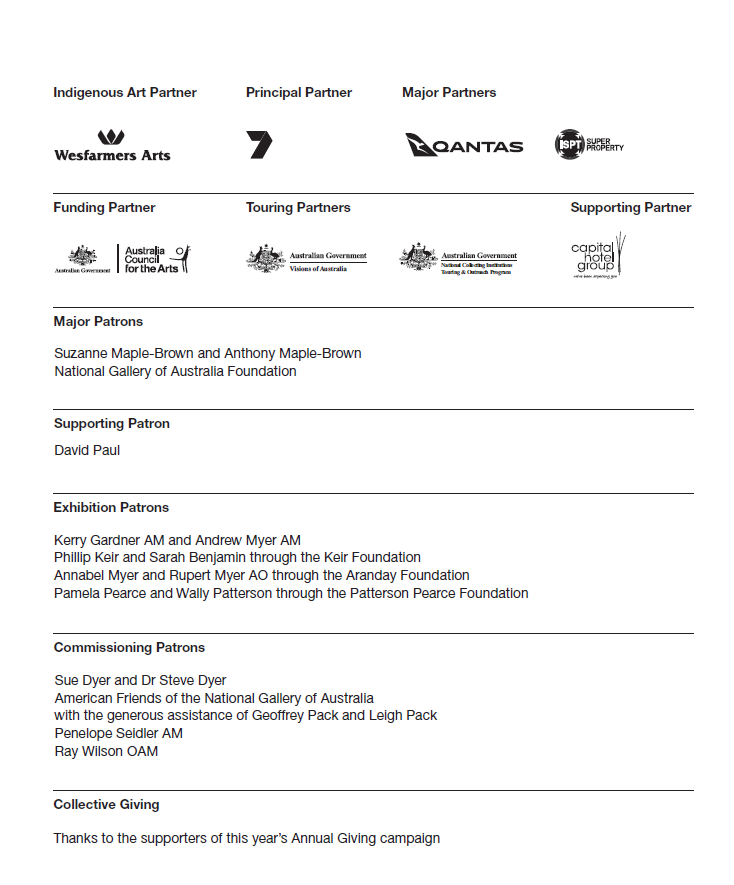
Partner logo grid (for use in EDMS, media release, ad placements):
Partner and sponsor acknowledgements in a full logo grid (for use in catalogue, title wall and
website):
STYLE GUIDE: Image captions
All captions to be reviewed by the appropriate curator before publishing unless previously approved.
1. SHORT ROLLING CAPTION
1.1. USAGE:
• audio guides
• films
• marketing collateral
• merchandise
• media
• media release
• social media
• advertising
Information to be listed in ALL captions (content in blue = as applicable)
Artist name
Language group
Artwork title
Date of creation
Collection
Collection credit line
Copyright credit line
Photographer credit
Style to be followed for ALL captions
,
,
,
,
,
,
Artist name Language group
Artwork title Date of creation Collection Collection credit line
,
Copyright credit line Photographer credit
Artist name, Language group,
Artwork title,
Date of creation, Collection, Collection credit line, Copyright
credit line, photo: Name
e.g.
Emily Kam Kngwarray, Anmatyerr people,
Kam, 1994, National Gallery of Australia, Kamberri/Canberra,
purchased 1995, © Emily Kam Kngwarray/Copyright Agency, 2024
Anne Dangar,
Urn with Chinese-inspired characters, 1948–49, Queensland Art Gallery | Gallery of Modern
Art, Meeanjin/Brisbane, purchased 2004, Queensland Art Gallery Foundation, photo: QAGOMA
Ethel Carrick,
In the Nice flower market,
c 1926, National Gallery of Australia, Kamberri/Canberra,
purchased 1972
1
Please follow rules as above for punctuation, capitalisation,
Dangar and Carrick
-
photo credits are listed in alphabetical order of institution/individual on the imprint page (searchable
by fig or cat number)
-
neither artists are in copyright.
Formatting rules
Artist name
-
always use full name
Language group
Artwork title
-
Always italicise the artwork title
-
If there is a publication, follow the title formatting exactly as listed in the book
-
A detail of a work of art (or cropping of an image) can be used if copyright permits. Details are
indicated by adding ‘(detail)’ after the year created:
The acid thrower, c 1896 (detail)
Date of creation
-
Always use the full four digits. Do not use ‘s’ when referring to blocks of time i.e 1940’s. This
should be c 1940
-
NO full stop after c
-
Date spans should use an en – dash
Collection
-
Lowercase ‘collection’ when referring to collections
-
Collection works always listed as - National Gallery of Australia, Kamberri/Canberra
Collection credit line
-
lower case
-
must be verbatim as supplied in Emu
-
lowercase i.e purchased, gift etc
Copyright credit line
-
Where copyright is the artist, we do not include the artist Gallery or representatives i.e. © John
Blogs courtesy of Plonk Gal ery would be only © John Blogs
-
The artist should always be lower case the and artist - ‘the artist’
Photographer credit
-
Written as - photo: Name
-
Advice from HR is National Gallery photographers are not named for privacy reasons
2

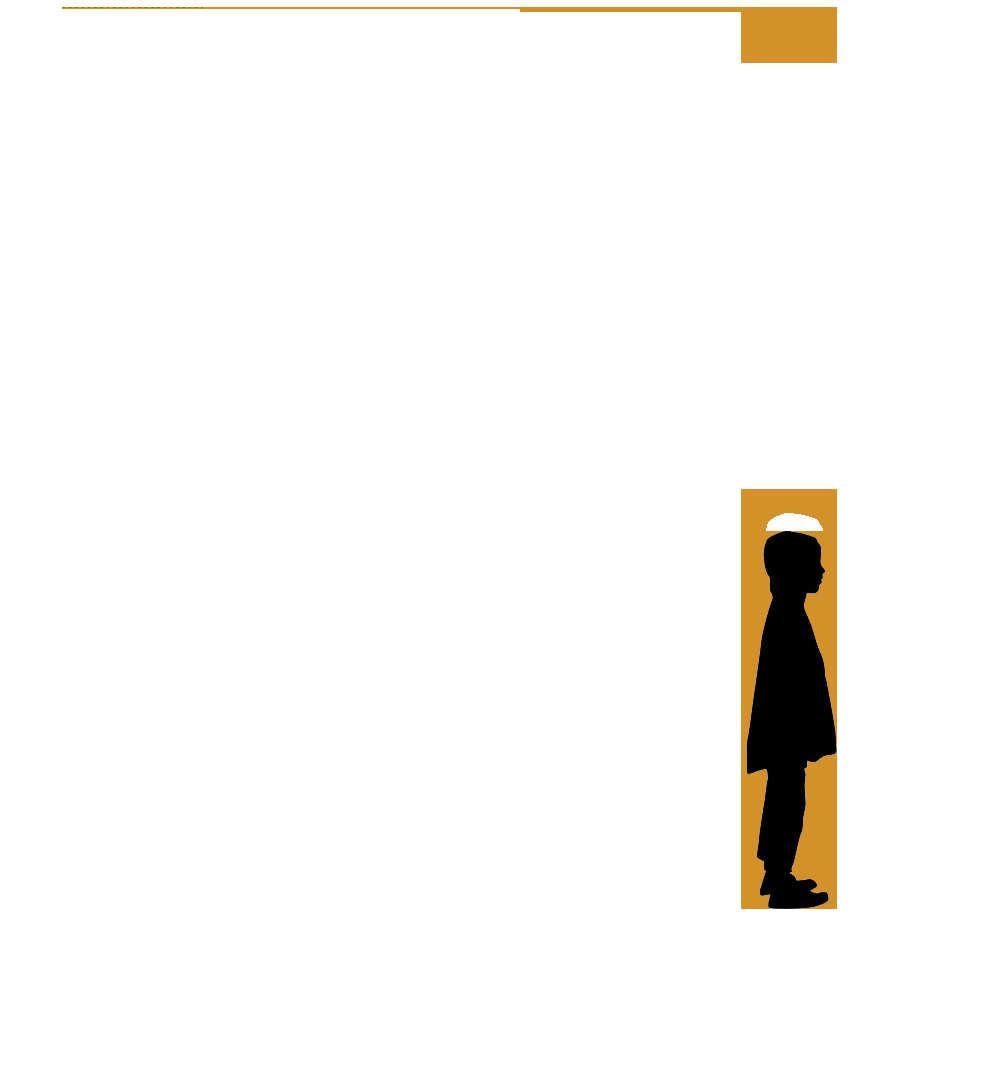
 ACCESSIBILITY TYPESETTING
ACCESSIBILITY TYPESETTING
– Minimum point size of 18pt for all interpretive material,
with 24pt for optimum readability for general object labels
– 36–50pt is optimum size for introductory or thematic panel texts
– Column width of <10–12 words (72 characters) recommended
by AIC, 50 characters preferable by Smithsonian
– Avoid using italics or ALL CAPS
– Close-set type can be daunting. Leave space between
paragraphs and keep your paragraphs short
– Provide sufficient leading (120% of pt. size)
– Provide consistent letterspacing and word spacing
– Justify the left margin and keep a ragged right margin
– Provide high contrast between text and background
Example. 0.75m distance = 24pt
Average viewing sight line
1m distance = 48pt
1830
1700mm Maximum eye level
2m distance = 100pt
3m distance = 148pt
1550mm Average eye level
750
1295mm wheelchair eye level
1000mm Minimum eye level
Sources
Smithsonian Guidelines for Accessible Design
Art Insitute of Chicago Interpretive Guidelines
Arts Access Australia
Museums & Galleries NSW
Probable Viewing Distance
Interpretative Type size
Less than 0.75M
24pt BRUT Regular
1m
48pt BRUT Regular
1.5m
65pt BRUT Regular
2m
100pt BRUT
Sources
Smithsonian Guidelines for Accessible Design
Art Insitute of Chicago Interpretive Guidelines
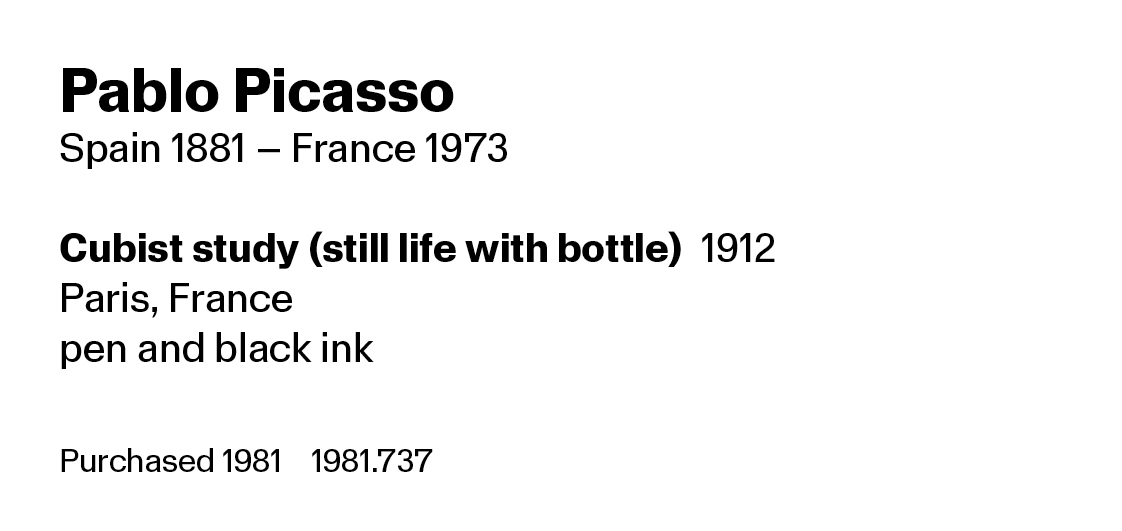
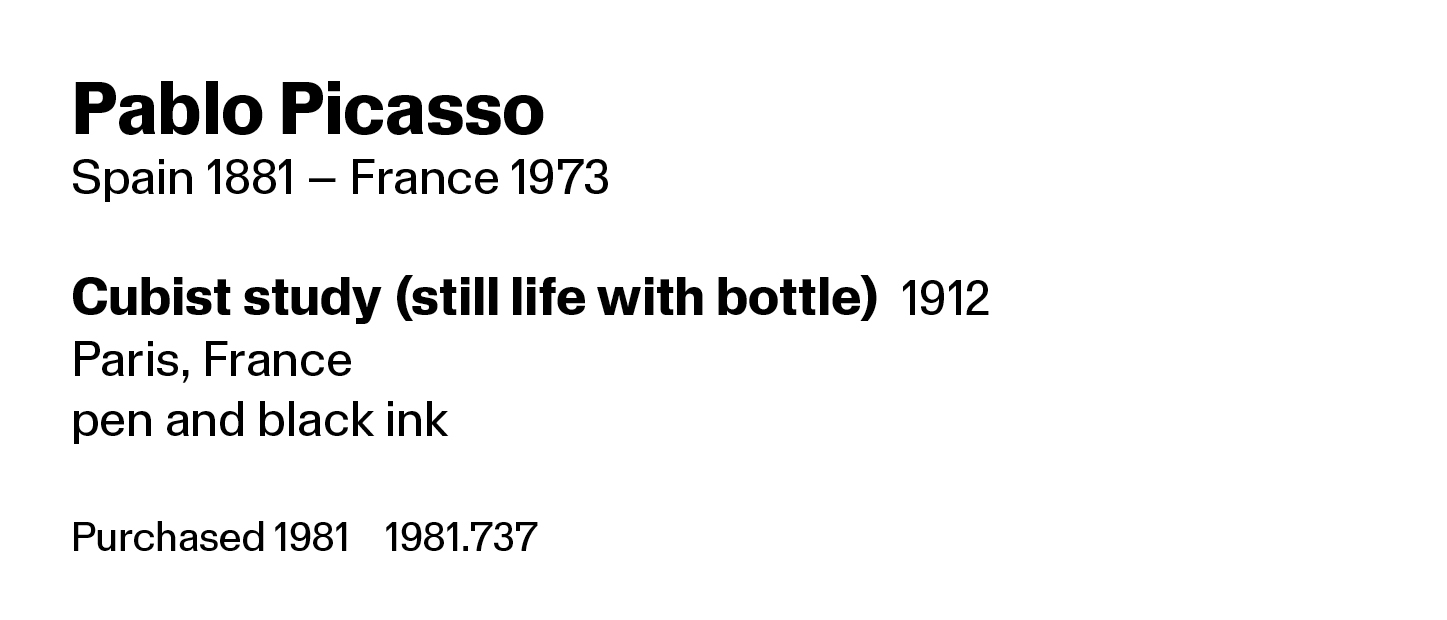
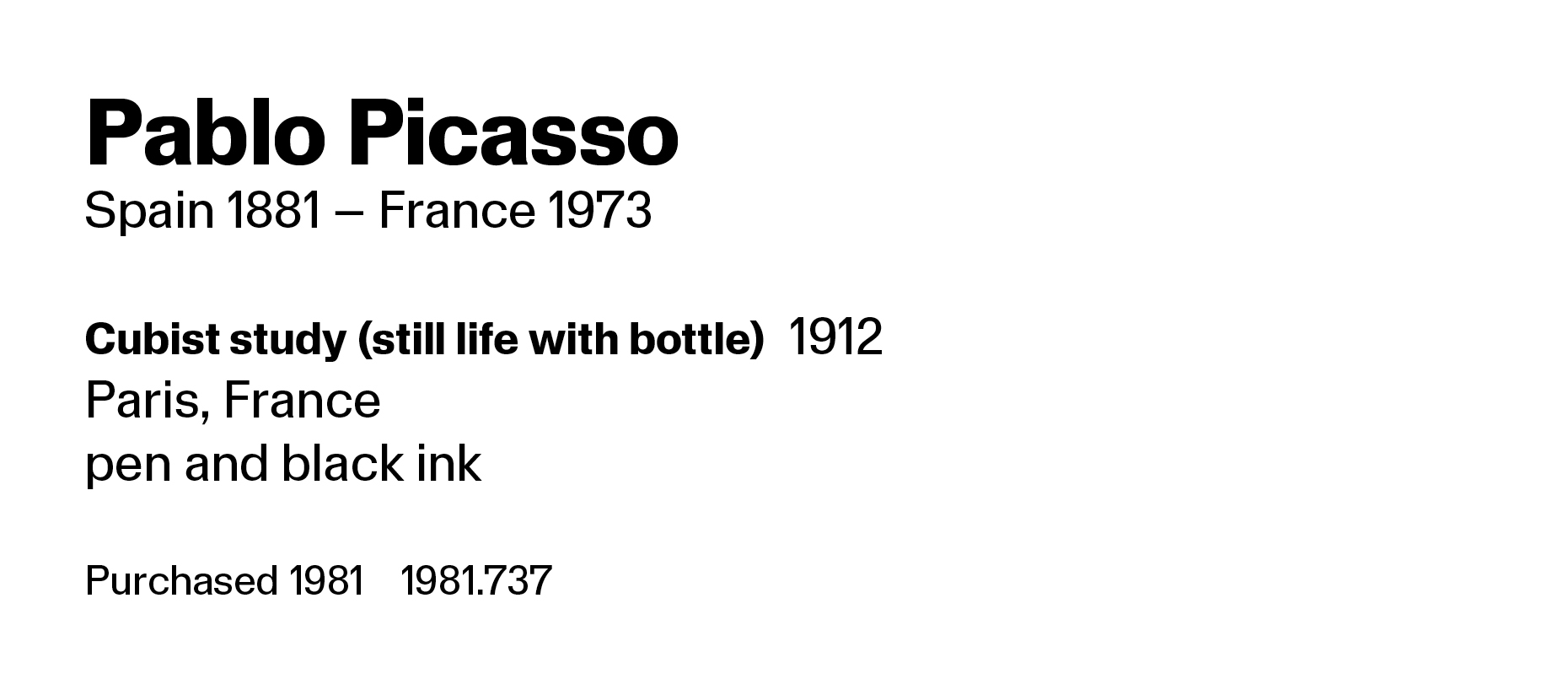 BRUT LABEL SIZES
BRUT LABEL SIZES
Labels Installed at 1200mm top line
Small label (showcase)
190mm W x Starting at 90mm H
Artist name
30pt
Work of art
20pt
Body text
20 pt
Credit line
16 pt
Medium label (permanent collection)
245mm W x Starting at 105mm H
Artist name
36pt
Work of art
26pt
Body text
24 pt
Credit line
20 pt
Large label (major exhibition)
315mm W x Starting at 140mm H
Artist name
54pt
Work of art
42pt
Body text
30 pt
Credit line
24 pt
BRUT LABEL SIZES
Louise Bourgeois 54pt
France 1911–United States of America 2010 30pt
Louise Bourgeois 36pt
C.O.Y.O.T.E. 1941–48/1979
42pt 30pt
France 1911–United States of America 2010 24pt
Louise Bourgeois 30pt
New York 30pt
France 1911–United States of America 2010 20pt
painted wood
C.O.Y.O.T.E. 1941–48/1979
24pt 24pt
New York 24pt
C.O.Y.O.T.E. 1941–48/1979 20pt 20pt
Purchased 1981 24pt
painted wood
New York 20pt
painted wood
For Bourgeois this sculpture represented ‘an army of legs’.
Purchased 1981 20pt
Purchased 1981 16pt
It was first titled
The march and
The blind leading the blind
For Bourgeois this sculpture represented ‘an army of 24pt
but in 1979 the artist renamed it and painted over the original
legs’. It was first titled
The march and
The blind leading
For Bourgeois this sculpture represented ‘an army of legs’.
red and black colour scheme. Her new title, C.O.Y.O.T.E. (Call
the blind but in 1979 the artist renamed it and painted
It was first titled
The march and
The blind leading the
Off Your Old Tired Ethics), is from a journal advocating for
over the original red and black colour scheme. Her new
blind but in 1979 the artist renamed it and painted over
the original red and black colour scheme. Her new title,
the legalisation of prostitution, and suggests allegiance to
title, C.O.Y.O.T.E. (Call Off Your Old Tired Ethics), is from a
C.O.Y.O.T.E. (Call Off Your Old Tired Ethics), is from a journal
the collective – a call for the right to self-determination and a
journal advocating for the legalisation of prostitution, and
suggests allegiance to the collective – a call for the right to
advocating for the legalisation of prostitution, and suggests
rallying cry against oppression. 30pt
self-determination and a rallying cry against oppression.
allegiance to the collective – a call for the right to self-
determination and a rallying cry against oppression. 20pt
Large Label
Medium Label
Small Label
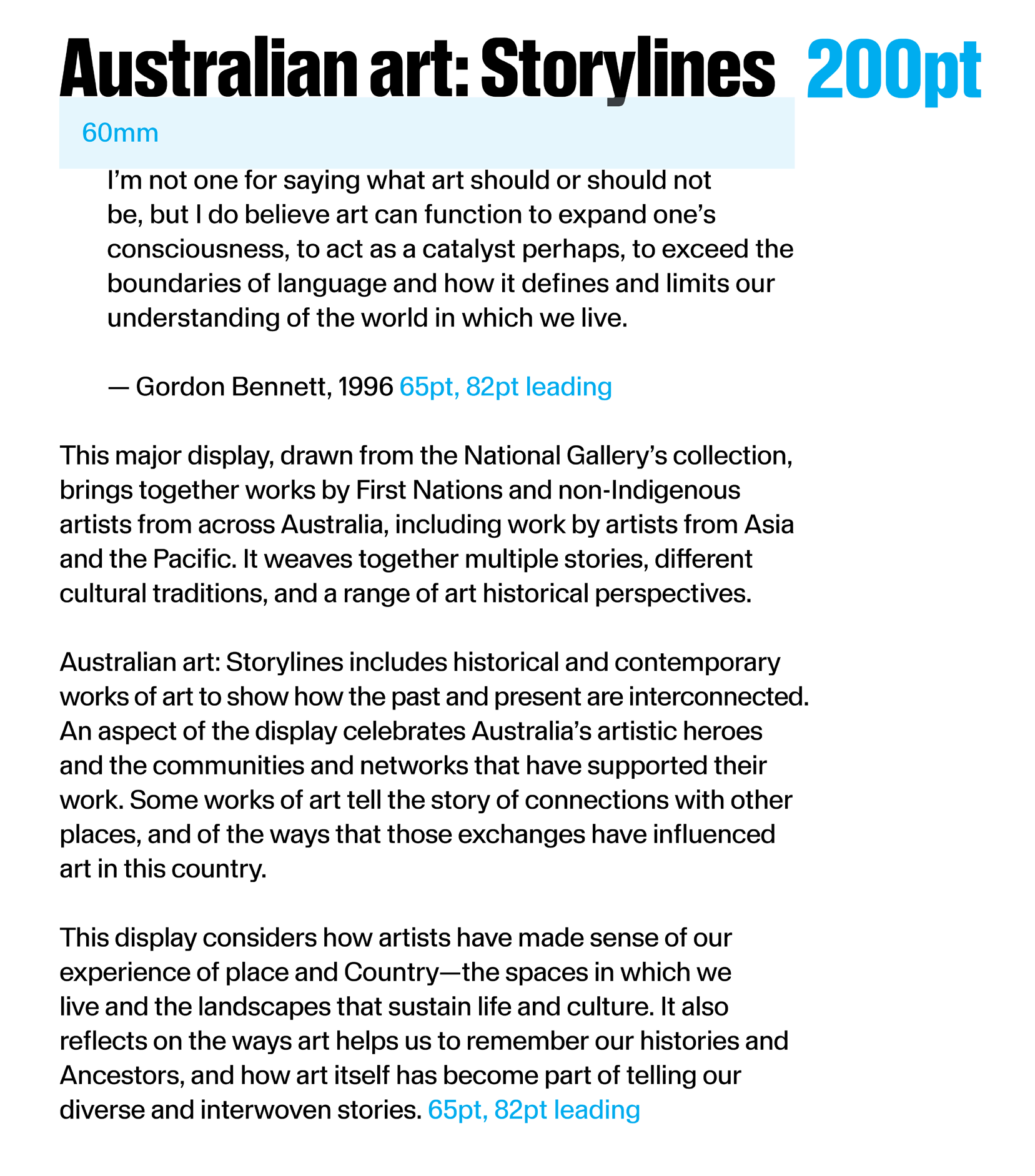 BRUT WALL TEXT
BRUT WALL TEXT
Wall text Installed at 1900mm top line
Vinyl cut lettering
Maximum 650mm W x Starting at 90mm H
Australian art: Storylines
I’m not one for saying what art should or should not
Title
200pt
be, but I do believe art can function to expand one’s
Body text
65pt
consciousness, to act as a catalyst perhaps, to exceed the
boundaries of language and how it defines and limits our
understanding of the world in which we live.
— Gordon Bennett, 1996
This major display, drawn from the National Gallery’s collection,
brings together works by First Nations and non-Indigenous
artists from across Australia, including work by artists from Asia
and the Pacific. It weaves together multiple stories, different
cultural traditions, and a range of art historical perspectives.
Australian art: Storylines includes historical and contemporary
works of art to show how the past and present are interconnected.
An aspect of the display celebrates Australia’s artistic heroes
and the communities and networks that have supported their
work. Some works of art tell the story of connections with other
places, and of the ways that those exchanges have influenced
art in this country.
This display considers how artists have made sense of our
experience of place and Country—the spaces in which we
live and the landscapes that sustain life and culture. It also
reflects on the ways art helps us to remember our histories and
Ancestors, and how art itself has become part of telling our
diverse and interwoven stories.


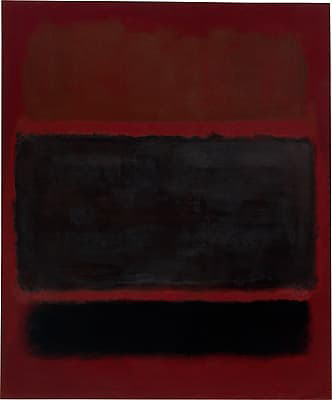 BRUT WALL TEXT AND LABEL HEIGHT
BRUT WALL TEXT AND LABEL HEIGHT
Scale 1:2
Option 2
1900mm wall text top line
1600mm centre line
1200mm label top line
Permanent collection wall text document
Page 17
Document Outline














